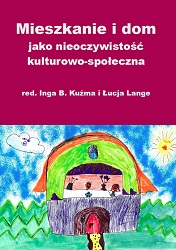
We kindly inform you that, as long as the subject affiliation of our 300.000+ articles is in progress, you might get unsufficient or no results on your third level or second level search. In this case, please broaden your search criteria.

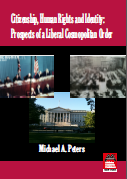
This book focuses on the notion of citizenship in relation to the notions of human rights, identity and culture. It poses the question of the prospects of a liberal cosmopolitan order dealing with a number of interrelated themes: ethics, emancipation and what Derrida calls the “new humanities;” identity, war and crimes against humanity; citizenship, and education rights within a knowledge economy; colonization, development and peace; changing notions of democracy within an information society; and culture, difference and otherness. These are the themes that make problematic aspects of the liberal cosmopolitan order. One of the main tropes connecting these themes is how the primary liberal values of freedom, emancipation and equality work out in a globalized world. The interrelationship of these values are problematized in different settings as they relate to issues of global world order with a focus on the adaptability of the liberal framework of values and law in creating a genuine cosmopolitan order.
More...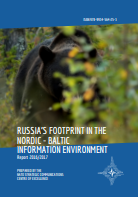
This volume presents the first results of the project ‘Russia’s (Dis)Information Activities Against the Nordic-Bal tic Region’, which was initiated in 2016 as an ongoing project for monitoring and analysing Russia’s information influence in the Nordic-Baltic region (NB8), which includes Den - mark, Estonia, Finland, Iceland, Norway, Latvia, Lithuania, and Sweden. In the period of 2016–2017 four pilot studies were conducted to answer questions about the aims of Russia’s information activities in the region; the use of the ‘compatriot’ policy as a tool of influence; the narratives Russia is using to advance its aims in the NB8 region; how the information provided by Russian state-funded media in some of the NB8 countries is used and how much it is trusted; and about public opinion regarding the narratives Russia promotes in some countries in the region. The main findings are structured around these research questions: What are the aims of Russia’s information activities in the NB8 region? • In the political dimension Russia aims to become one of the great powers in the new polycentric world order, to become an equal player in the international system, to challenge the unipolar world order, to counter the post-Cold War interventions of the West, to counter Western liberal democracy as a universal value, to call for the revival of Westphalian sovereignty, and to subvert the unity of the Western states. • In the military dimension Russia aims to counter NATO expansion towards Russia’s borders and to combine military force with other instruments of power. • In the economic dimension the Arctic as a region is a priority for Russia, as well as economic interdependence with the other countries in the region. • In the informational dimension Russia aims to develop its own global media system for the promotion of its worldview, to position itself as a distinct civilization, to support Russian ‘compatriots abroad’, and to develop the concept of the ‘Russian World’—an ideological space that exceeds the territorial boundaries of Russia, as well as to promote its own perspective on Russian and world history. • The main tools for advancing Russia’s aims are identified as: Russia’s domestic and international media system; the Internet and social media; government-organized nongovernmental organizations (GONGOs); Russia’s compatriot policy; pipeline diplomacy; economic interdependency; the encouragement of political radicalization and polarization of Western societies; intelligence operations; and demonstrations of military force. How is Russia’s compatriot policy being used as a tool of influence in the NB8 region? • The concept of Russia’s ‘compatriots abroad’ is rather ambiguous and widely interpretable, which gives Russia an opportunity to use the idea of protecting compatriots’ rights as a moral justification for interfering in the internal matters of the sovereign states, for using military force, and for violating the territorial integrity of its neighbouring states. • However, the number of people who identify themselves as Russia’s compatriots may be at least three times smaller than officially estimated by Moscow. Due to the vagueness of the concept the actual number of compatriots is difficult to verify. • There is a gap between the scope of Russia’s compatriot policy as it is officially declared and organized and the strength of Russia’s actual relationship with its compatriots abroad. The organization of Russia’s compatriot activities abroad is rather formal, not well known among or representative of Russian speaking communities abroad, and characterized by internal conflicts. As a result, there is no genuine link between Russia and its compatriots abroad, despite an active state policy. • However, from the perspective of the national security of the NB8 countries, the main concern is not the actual interactions between Russia and its compatriots in the region, but the fact that the narrative of ‘discrimination’ may be used as a political excuse for intervention, as evidenced by the five-day war with Georgia and the crisis in Eastern Ukraine. It may be assumed that Russia exaggerates both the number of its compatriots and the effects of activities to ‘engage’ with them, so that Russia can intervene (if expedient) to ‘protect’ them in a military or non-military manner. • Latvia and Estonia are the countries most vulnerable to the application of the narrative regarding the violation of the rights of Russia’s compatriots, due to their large number of ethnic Russians and speakers of the Russian language as their first language, and to the phenomenon of ‘non-citizens’—people who immigrated to Latvia or Estonia during the Soviet occupation and could have applied for citizenship through naturalization once these countries regained their independence, but have chosen not to do so.1 If Russia chooses to use this narrative as a basis for violations of sovereignty it will be determined by its strategic interests rather than by any perceived discrimination against Russia’s compatriots, be - cause it is a tool and not a strategic goal. • The regional coordination of Russia’s compatriot policy began in 2015, when the Regional Coordination Council of the Northern Europe and the Baltic Sea countries was established. From the perspective of coordinating Russia’s compatriot policy, the Baltic States belong to Northern Europe instead of the ‘Near Abroad’. • The most intensely promoted of Russia’s compatriot activities in the NB8 region is the propagation of Russia’s historical narratives, which are mainly related to the victory of the Soviet Union in World War II. These activities take place in all NB8 countries. • Marginalizing Russia’s compatriot organizations and activists in the Baltic States reduces the possibility of Russia using them as a ‘soft power tool’. Russia’s opportunities for using soft power have been diminished by the Ukrainian crisis because of the increased wariness towards such activities. What narratives is Russia using to advance its goals in the NB8 region? • There were regional differences in terms of the application of certain narratives in relation to the NB8 countries by RT, Sputnik, and Perviy kanal in 2016. Regarding the Baltic States, Russian media have been most concerned with military issues—the two most used narratives were that NATO is a threat to Russia and that the idea of a Russian threat to the West is ridiculous. The analysed Russian media were more concerned with NATO and the activities of the alliance close to its borders, rather than specific is - sues within the Baltic States. • The most common narratives in relation to the Nordic countries were that refugees and migrants are a destabilising factor, and such related narratives as radi - cal Islam is a destabilising factor and far-right nationalism is on the rise, which provide evidence that Russia is attempting to amplify the destructive processes caused by the refugee crisis within Europe. • Another common narrative that emerged in the context of the Nordic countries was that the Arctic is a territory of dialogue, which is, that the interests of Russia and the Nordic countries overlap in this region and Russia’s intention is to solve these issues by peaceful negotiation, as stated in Russia’s Foreign Policy Concept. • Apart from these common regional trends, there were also some country-specific narratives. In the case of Latvia, the second most common narrative was discrimination against minorities. Estonia and Latvia have similar issues with their ethnic Russian population; nevertheless, in the case of Estonia the discrimination narrative was ob - served only three times, where - as there were more than 20 discrimination-related articles about Latvia. These data show that Latvia is the main target for the application of the discrimination against minorities narrative. • Norway and Iceland were used as role models in the context of the Brexit referendum, suggesting that these countries may do better without the EU and thus strengthening the narrative of diminishing unity in the EU. • The second most common narrative in relation to Finland was that Finland and Russia are good partners, no matter what. This is indicative of Russia’s attempt to build and strengthen bilateral relations with European countries. • Sweden stood out with the narrative Sweden is part of an unjust persecution of Julian Assange, showing how important the issues related to the WikiLeaks founder are for Russia. How useful and how trusted is the information provided by Russian state-funded media in the Baltic States, Finland, and Sweden? • In the states surveyed, the use of Russia’s global media outlets RT and Sputnik is limited. The general trend is that the majority of communities in the Baltic States are aware of these Russian media outlets, but do not use them (more than 60%), whereas most communities in Finland and Sweden are not aware of these media at all (more than 50%). • Of the Russian media included in the survey, Perviy kanal is the most influential in terms of the audience numbers reached, albeit there are regional differences. An average of 38% of respondents in the Baltic States reported watching Perviy kanal, whereas the majority of respondents in Finland (83%) and Sweden (67%) were not aware of the media outlet. • The demographic profile of the Russian media users surveyed gives evidence that the use of RT and Perviy kanal (the use of Sputnik is so small that it is impossible to make any analysis of the demographic profile of its users within this survey) is linked to the use of the Russian language, thus making these Russian media outlets an integral part of the so called ‘Russian World’. • The results of the survey also give evidence that Russia is not a trusted source of information in the Baltic States, Finland, and Sweden, except among a part of Russian speaking audiences in the Baltic States. What is the public opinion about the narratives promoted by Russia in the Baltic States, Finland, and Sweden? • The main finding in relation to public opinion is that if the views of the respondents overlap with the narratives promoted by the Kremlin, this overlap is not correlated with the use RT, Sputnik, and Perviy kanal. It is necessary to understand that due to methodological constraints and the existence of other determinants for public opinion that were not researched in this study, the over - lap between reported opinions and the Kremlin’s narratives may not be interpreted as the result of Russia’s influence. • The narrative refugees and immigrants are a destabilising factor for Europe gained the most support in Estonia (77% fully agree & agree somewhat) and Latvia (72% fully agree & agree somewhat). In Lithuania and Finland support for the statement was somewhat smaller, albeit still high—69% and 63% of those who agree fully and somewhat, but in Sweden this statement gained the least sup - port—only 46% of respondents agreed fully and somewhat. • The highest support for the narrative that a rebirth of neo-Nazism is taking place in Europe was identified in Sweden (74% fully agree & agree somewhat) and Finland (65% fully agree & agree somewhat)—the countries where consumption of RT, Sputnik, and Perviy kanal was the smallest. • The answers given by respon - dents about the narrative Russian speaking people in Latvia experience discrimination indicate that there is little interest regarding this issue in the neighbouring countries—29% of respondents in Lithuania, 30% in Finland, 41% in Estonia, and 60% in Sweden answered that they have no opinion about it. Respondents in Latvia have a strong resistance to this narrative—54% fully disagreed with the statement and 20% disagreed somewhat (74% of all respondents disagreed). • The response to the question regarding the narrative that Sweden is part of the unjust persecution of WikiLeaks founder Julian Assange suggests that some of the narratives Russia is promoting are not at all important for the people of the surveyed countries, as 70% of respondents in Latvia, 69% in Lithuania, 63% in Estonia, 41% in Sweden, and 22% in Fin - land have no opinion about this issue. • NATO is one topic that polarizes opinion in the Baltic States between those who use Russian as their first language and the titular nationalities. The general trend is that titular nationalities are more supportive of a NATO presence in their countries. Therefore the most surprising results in relation to the narrative NATO is a threat to Russia are found in Lat - via, because 45% of respondents fully disagree and 23% disagree somewhat (in total—68%) with the statement, despite the demographics and the high consumption of Russian media in the country.
More...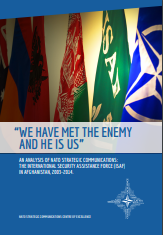
The 2003-2014 UN-mandated, NATO-led ISAF mission, which featured ground combat for the first time in the Alliance’s history, took a tremendous human and financial toll. By ISAF mission end, well over 1 million NATO troops and civilians had served in theatre along with hundreds of thousands of contractors. Reliable studies conservatively estimate the financial cost to be at least $1 trillion US dollars. Almost 3,500 troops under NATO command from 29 nations paid the ultimate price, and tens of thousands more suffered serious injury. Afghanistan has been a security-related point of discussion and a major part of Western military efforts for almost a fifth of NATO’s existence. By virtually any metric it is the longest, most complex, expensive, challenging and fractious operation in NATO’s history. As a result of the massive NATO and international effort – by any socioeconomic or human development index measure – Afghanistan in 2015 is a considerably better place as a result. That is hardly to say outcomes were optimal, or that NATO helped Afghan government forces decisively defeat the insurgency: they were not, and they did not. A commonly held view is that NATO also ‘lost’ the Afghanistan strategic communication campaign. This report is an effort to deduce what is NATO and ISAF’s score on that point, and if it did not ‘win’ outright then how did Strategic Communications (StratCom) perform? Within the political-military leadership and even within the communications community there are factions of passionate supporters for StratCom and just as many opponents. All seem to agree conceptually of the need for better coordination as long as they are the ‘coordinators’ and not the ‘coordinated’. Throughout ISAF’s duration these factions were often at odds and even as they clashed, the operating and information environment transformed. This should have led to a wholesale re-evaluation of optimal structure, process and capabilities: it did not. Still, as to be expected from the accumulated experience of continuous operations over 11-plus years of the NATO-led ISAF mission, some new capabilities were added that improved how NATO communicated with national domestic audiences including the Media Operations Centre and NATO TV. But the nub of the issues and the old debates – influence versus inform, the public affairs reporting relationship to the commander, measuring effect, how to better synchronise effort – are the same discussions as 5, 10 and even 15 years ago. The current impetus for reform has little to do with lessons learned during ISAF. It does however, have much to do with the Russia/Ukraine crisis. Given the contemporary security environment, the extent to which unsatisfactory campaign outcomes should be attributed to the communication effort is not an inconsequential subject. Today’s information environment bears little resemblance to what it was at the start of the ISAF mission in 2001, in large measure a result of widespread access to reliable Internet, the ubiquity of smart phones, and the global scope and penetration of social media. In the past decade we have transitioned from grasping the implications of the ‘strategic corporal’ to dealing with the operational consequences of the ‘strategic tweet’. Adversaries also became very capable at using new communication tools to their advantage. While it may be unlikely that the Alliance will fight another mission quite like ISAF, many observations can be drawn from ISAF about whether NATO communication-related policy, doctrine, structures and capabilities are fit for purpose in future campaigns. This report offers 12 recommendations where effort and resources might be applied to achieve more favourable outcomes. A North Atlantic Council-approved policy in August 2009 defines NATO StratCom as “the coordinated and appropriate use of NATO communications activities and capabilities ... in support of Alliance policies, operations and activities, and in order to advance NATO’s aims.” Still, the actions and practice during ISAF demonstrate that NATO aspires to achieve more for its strategic communications investment, and that it is increasingly about understanding the desired effect or behavioural change required to shape what to do, say, show and signal to inform, persuade or influence audiences in support of specific objectives. NATO HQs had two strategic communications campaigns to fight during the ISAF operation, the first being for the support of domestic audiences of the 51 troop contributing nations and international audiences. Given the policy hand it was dealt, the manner in which the operation was executed for the better part of a decade, the high operational tempo at NATO and zero nominal growth (thus, downsizing) forced on it by nations, the Alliance communication effort did considerably better than it is given credit for, in particular at NATO HQ in Brussels and Allied Command Operations, and for stretches of time at ISAF. This is a finding that may strike many as counter-intuitive. The second campaign was the operational battle for the contested population and against malign actors including the Taliban. If success is measured against information policy aims: “...create desired effects on the will, understanding and capability of adversaries and potential adversaries” (Information Operations); “to influence perceptions, attitudes and behaviour, affecting the achievement of political and military objectives” (Psychological Operations); and “to inform, persuade, or influence audiences in support of NATO aims and objectives” (StratCom), then the outcomes are decidedly more mixed, if not a failure. A detailed assessment of capability and performance in this report supports the argument that ISAF was a case of a fundamentally flawed political/ command structure that was by its structural nature incapable of devising and directing a unified political-military campaign. The international community brought a sense of hubris to that shattered country which had virtually no licit economy or capacity for effective governance. It set unreasonable objectives, looked for short-term metrics of success, and wholly underresourced the mission for almost 10 years. The strategy often changed, or was confused, or was conflicted. It took few Afghan views into account. No answer could be found to effectively deal with the vexing question of Pakistan where insurgent forces found sanctuary. NATO then proceeded to break or subsume most of the principles of war, foremost being ‘selection and maintenance of the aim’, ‘unity of effort’ and ‘unity of command’. But how fair is that considering Afghanistan was a major international endeavour, that the NATO mission has lasted this long and will continue for the foreseeable future albeit in different form, that support in the country for international forces remains high, and that troop contributing nations have not endured major political recriminations from their populations? Taking a long view, the ISAF communications effort cannot have been a failure. The magnitude of collective effort by NATO nations over that period of time is a considerable expression of Alliance will and stamina. From the political-military centre of gravity perspective of “maintaining the solidarity, cohesion and credibility of the Alliance”, this alone points to a strategic success broadly speaking. This report finds that improved StratCom did not, and does not, temper the effects of bad policy and poor operational execution. In the end, strategic communications outcomes weren’t nearly what they could have been but were considerably better than critics suggest. Where policy and operations were well connected and showed results, StratCom amplified that effect. Where policy and operations were weak, negative outcomes could be mitigated but not overcome. Improving strategic communication effects needs to start with better policy, greater understanding of audiences including motivations, conducting operations following established and successful military principles, and skilled practitioners. In that respect, the weakest link in the Alliance communication effort at strategic, operational and tactical levels was the profound lack of trained, expeditionary communication- and information-related military capability in almost all NATO member nations (excepting the U.S., and perhaps Germany). For NATO to be more effective, nations need to professionalise their approach to communications by abandoning the model of employing ‘willing general service officers eager to learn on the job’ to one that is firmly based on ‘qualified, trained and experienced practitioners in all disciplines at each rank level’. ISAF served as a forcing function for incremental albeit important improvements to NATO communication-related policy, capability and capacity aggregated over more than a decade of continuous operations. However, the transformation of the information environment happened much faster than NATO HQs and member nations were able to evolve their communications-related mindset, structures, capabilities and outputs. The real catalyst for the current effort to make substantive reforms has been Russia’s attack on Ukraine. In this regard the Wales Summit Hybrid Warfare initiatives identified a series of actions that if implemented would be a major upgrade to the Alliance’s ability to compete in the new information environment.
More...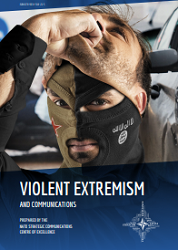
The aim of the project is to build awareness regarding this emerging threat, and to come to a common understanding about what drives the organizations that use extreme violence to defend their ideologies. Most importantly, our aim was to understand the roots of such violence—the seed of an idea flowers into an ideology, which leading proponents and followers further communicate to potential supporters. Although the existing literature extensively describes the problem, this report was greatly enriched by the seminars, working groups, and one-on-one academic discussions I had the privilege of participating in over the past year.
More...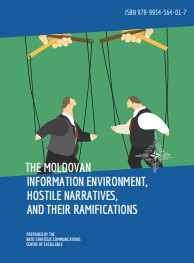
This study describes the current information environment of Moldova. The main focus is on how societal vulnerabilities are exploited by political actors who are following policies promoted by the Kremlin. The mechanisms linking societal vulnerabilities and people’s behaviour are described here in order to better understand the Moldovan information environment, especially the Russian influence on Moldovan politics. Compared to a traditional target audience analysis, this study highlights the importance of the structure of media environment, which promotes hostile Kremlin narratives in Moldova (see picture page 5). This study assumes that societal problems are not discussed in a vacuum. Moldovans’ perception of what is going on around them and the actions they take in response are shaped by the structure of and key actors in the media environment. As a result, only some topics are selected for public consumption. The chapters that follow describe the vulnerabilities in today’s Moldovan society, the divisive narratives promoted by the Kremlin and its local affiliates, local media ownership and control, and the most influential opinion-leaders in Moldova. Conclusions and recommendations are given at the end of each section. People living in Moldova today worry about their children’s future, poverty, unemployment, prices, corruption, and the possibility of war. This report highlights the importance of corruption, weak state structures, the dysfunctional political system, and the regions of Transnistria and Gagauzia as the major vulnerabilities currently faced by Moldovan society. All of these issues are closely linked to both poverty and the lack of security many people feel in the unstable political environment. These vulnerabilities are effectively leveraged to foster mistrust and polarization. After analysing the situation, we cluster Kremlin promoted messages, speeches, videos, demonstrations, and other acts. We consider these clusters as four identifiable hostile narratives that serve to create divisions in an already fragmented society. We have named them ‘Russkii Mir and Soviet Nostalgia’, ‘Federalization Will Ensure Equality’, ‘The European Union is Bad, Russia’s Customs Union is What You Need’, and ‘Romania and NATO are a Threat to Peace’. Each of these narratives targets feelings and emotions—the sense of belonging, the sense of selfdetermination, a sense of economic security, and a sense of physical security. Each narrative touches upon particular Moldovan vulnerabilities, but the tactics behind them can be recognised in other, similar narratives promoted by Vladimir Putin’s Kremlin in other countries along the Russian border. The ideas in these hostile narratives overlap, sharing many of the same features. For instance, ideological conservatism supports both cultural propagation and is opposed to economic ties with the European Union. These narratives can also be contradictory, such as the idea of Russkii Mir, which attempts to link the Moldovans more closely to their former Russian rulers, while federalization strategy claims to promote self-determination for the ethnic Moldovan majority. Therefore, hostile narratives are not meant as idealized truth that the audience should swallow whole. Instead, individuals pick and choose the story elements that make sense to them, like choosing dishes from a buffet. What is crucial is that people accept a portion of the misleading information, which itself is enough to deepen the wedges between the various factions of Moldovan society. Post-Soviet narratives are a mix of residual memories, political failures, and regional conflicts. Ideological narratives affect minds and public behaviour via emotions and iconic images. The ‘Russkii Mir and Soviet Nostalgia’ narrative inspires unity between Moldovans and Russia on an emotional, even spiritual, level. The idea of Russkii Mir,’ or ‘the Russian world’, is an ideology built on the assumption that those who speak Russian think and act like the subset of Russians currently in power. In Moldova, this manifests itself through emphasizing Russian Orthodox religion, remembering and cherishing the sacrifices made during the Great Patriotic War, and clearly distinguishing between Moldova and Romania. These are attempts to create positive feelings about influence from the East and sharing the conservative Russian mental space. The ‘Federalization Will Ensure Equality’ narrative comprises acts and messages that stress the equality of different ethnic groups living in Moldova. Here Russia wants to take on the role of an alternative to the Moldovan titular group. The portrayal of Russians as the most important linguistic minority can be challenged. Not only is the size of Ukrainian population bigger, but Russians are closely followed by other groups in number. Politically, federalization might create veto-rights for the administrative areas of Transnistria and Gagauzia, which themselves are closely linked with Russia due to various historical circumstances. The narrative ‘The European Union is Bad, Russia’s Customs Union is What You Need’ seems to be about economics, but actually the arguments used are often based on ideological conservatism and used to create fear among Moldovans. The related Kremlin narrative, ‘Romania and NATO are a Threat to Peace’, leverages people’s sense of insecurity. Echoing messages from the Kremlin, some political leaders are claiming that Western expansionism is underway, or that NATO and Romania have ambitions towards the East. The narrative has produced results: a large number of Moldovans favour both Vladimir Putin and political neutrality, which suggests that these audiences do not see the risks the current Russian regime poses to the region. These narratives are most powerfully communicated through various forms of media. Without a mechanism for the transmission of these narratives, they would have a limited audience and those sending messages would be unable to bring about changes in the behaviour of the people they seek to influence. For the most part, the Moldovan people are only exposed to that information, which local powerbrokers or the Kremlin-controlled media want them to be aware of. At the moment Moldova has too many media outlets for them all to remain economically viable in the small Moldovan economy. This reduces the quality of the news and creates an incentive for affluent actors to promote their own agendas. A handful of individuals in Moldova and the Kremlin are effectively dominating the news landscape. Much of the control lies in the hands of politicians or oligarchs such as Vladimir Plahotniuc, who has consolidated his business and political power structure, leveraging also his media assets. Plahotniuc plays a leading role in the pro-Western Democratic Party of Moldova, while his television channels run programming produced by Kremlin-controlled media. Some other influential politicians and businessmen active in the media include Chiril Luchinschi, Vlad Filat, Vadim Ciubara, Victor Țopa, Dan Lozovan, Dumitru Țîra, and Ilan Shor. This report includes charts showing who controls the Moldovan media (see picture page 48) and which parties are affiliated with pro-Kremlin and Pro-Western media outlets. (see picture page 47). The media is a pipeline that carries content. Journalists and researchers, who influence the national agenda, create the content. They are influential because audiences see and hear them actively analysing and discussing pressing issues. According to our study, some of the most influential opinion-makers were Corneliu Ciurea, Serghei Ostaf, Veaceslav Ionita, Victor Gurau, and Alexandru Cauia, who happen to be especially popular on platforms connected with Plahotniuc. Because the situation in Moldova shows every indication of remaining challenging, there will be a constant stream of opportunities to negatively affect the fragile development of proWestern narratives. Hostile narratives can be fine-tuned and kept alive with minimal effort. Adversarial forces needn’t actively worsen the current situation, as conditions are already bad. In the current political climate, Western values are under attack. In Moldova, neither the public sector, nor the public at large are clear about where they want to be heading. While the Kremlin is clearly leveraging the vulnerabilities of Moldova, the population itself is divided along several lines. Self-interest, greed, and lust for power are often veiled in political rhetoric, which makes evaluating the information environment challenging. Large segments of Moldovan society are inclined to agree with messaging originating from the Kremlin, while the pro-Western segments of the population are divided on a number of issues. The current Moldovan understanding of Western or European values is often distorted either by adversaries, or by noncredible proponents of alternative messages. There are many flag carriers for European values in Moldova, but many others exploit fears about Russia for their own benefit. In order for the voices representing truth and justice to be heard in the Moldovan information environment, the country and its people will continue to need support from free and open societies. Adversaries can affect decision making, first by distorting the quality of information, second by controlling access to information, and third by influencing people’s perception and understanding of the information they do come into contact with. There are several ways Moldova and its partners can help to protect Moldovan society along these lines. First, there are various ways to improve information quality in Moldova. Western values can be promoted using current media structures. The political agenda of each media outlet is partly moulded by a circumscribed number of opinion leaders, many of whom are discussed in this study. Offering good journalistic content to the existing popular channels is a way to improve understanding among audiences. Adding new channels is not effective in an already saturated market. Radio Free Europe/Radio Liberty Moldova has managed to include both Romanian and Russian language programming on Moldova’s public TV and radio channels. Second, access to information might require marketing, more attractive programming as well as technical solutions. Large segments of the Moldovan population have limited access to high-quality information. They are barely in the Moldovan media space but voluntarily rely on Kremlin news sources. It is very difficult to reach these people if they are stuck in their media habits and not used to searching for news from different sources. To find a way to break through to individuals caught in this type of Kremlin information bubble, we should further analyse what kind of content, e.g. entertaining or journalistic, would encourage people to change their media habits. In Transnistria and Gagauzia there are even fewer opportunities to get Moldovan or Western content due to local broadcasting decisions, so reaching them requires other technical solutions. Third, protecting perceptions and understanding is the most difficult issue to solve. Proposals for various types of co-operation projects that would bring Moldova into closer contact with the rest of Europe and provide work in Transnistria and Gagauzia are especially relevant, as they are more isolated from the West. The situation in these regions is only one symptom of the problem. As long as there is no shared national vision about present realities and the future goals, all solutions remain partial. The Moldovan authorities and citizens must bear the brunt of the responsibility for creating new opportunities and developing cohesion among the inhabitants of the country. Western support for the Moldovan people, especially for education, rule of law, functioning state structures, and quality journalism will bear fruit in the long run. To summarize the policy recommendations, we are suggesting improving quality journalism leveraging the current media structures, targeting marketing and projects aimed at bursting proKremlin information bubbles, and continued co-operation in supporting the Moldovan response to improve state vulnerabilities.
More...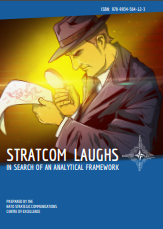
The study “StratCom laughs. In search of an analytical framework“ is a multidisciplinary effort to design an analytical framework for analysing humour in scenarios where researchers and practitioners find themselves working through large data collections where humour has been used as a potent tool in the construction of messages designed for strategic communication. The research was conducted in four stages. The first stage approaches the concept of humour from the perspectives of cognitive, communication, political science and psychology. The relevant components of humour, namely shared knowledge, target audience, perception, function and message delivery have been factored in.
More...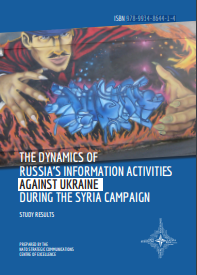
Two major geopolitical conflicts are at the core of this research. Military conflict in Syria and the related rise of terrorism carried out by Daesh, in both the region and beyond, pose an enormous policy challenge for the governments of the United States of America (US) and Europe. Simultaneously, Russia faces sanctions after it annexed Crimea – the biggest and most serious geopolitical violation of national borders in the 21st century so far. This paper provides an analysis of the dynamics and changes in the level of Russia’s information activities against Ukraine before and after the commencement of the Syrian campaign. The analysis proves that, despite the geographical distance between them, both conflicts share mutually coordinated strategic narratives promoted by Russia. This report argues that the strategic goals of the Russian government’s propaganda are the following: • to promote Russia as a crucial player in the polycentric world in the process of international peace; • to claim Russia’s superiority over the US; • to prevent Ukraine’s transformation into being part of the external border of NATO and the European Union (EU); • to soften and, in the nearest future, achieve the lifting of the sanctions regime against Russia.
More...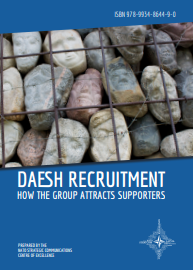
To be successful, an organization must have a carefully prepared strategy communicated through the proper channels, which leads to the implementation of actions that will result in the desired end state. The process used to achieve coherence between communication and information activities, closing the gap between words, visuals, and actions is known as strategic communication. In order to be effective, strategic communication must involve both charismatic leaders and active communicators. A well thought out recruitment campaign is essential to identifying and acquiring sufficient human resources. Recruitment is a function of human resource management and refers to the process of attracting, selecting, and appointing suitable candidates for specific positions within an organisation. Just as legally operating institutions choose the best people they can find to fulfil specific needs, organized crime and terrorist organizations must recruit people to carry out their plans. The main goal is to attract the attention of potential audiences and draw them into the organisation, either regionally or globally. Daesh has been working in its strategic communications to attract the attention of people who may be willing to support Abu Bakr Al-Baghdadi’s ideology. Daesh youth recruitment has history of its own, which is as old as the organization itself. Their approach to recruitment plays a vital role in sustaining the number of foreign terrorist fighters and many other kinds of supporters who are an essential part of the overall strategy. If we only think of Daesh recruits as foreign fighters, we are not thinking broadly enough. Of course, any recruit could potentially become a foreign or domestic fighter. A ‘foreign fighter’ is a terrorist who comes from any country other than Syria and Iraq to support Daesh in battle. However, it is important to keep in mind that the recruitment campaign is not reserved only for those who choose to fight. The campaign targets many other audiences, including those who stay in their own countries and support Daesh by executing a great many tasks necessary for the operation of the organisation. Therefore, to understand the communication strategy of the terrorists, we must first understand how Daesh wants to be supported and what motivates possible Daesh recruits. This study focuses on the ‘Support Line of Effort’ mentioned in the previous report on Daesh published by the NATO StratCom CoE. The main objectives of this report are to show who is a potentially target for Daesh recruitment, what motivates people to support Daesh, and to identify the steps recruiters take to secure new members. The Centre has been analysing Daesh products on a monthly basis. These monthly assessments have been used to calculate what percentage of the overall communication strategy is dedicated to recruitment support. They also provide some indication of what steps are being taken and what techniques Daesh has been using to staff its terrorism and intimidation projects.
More...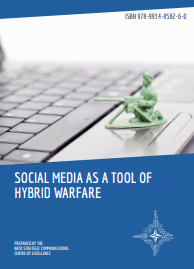
The development of information technology has changed the nature of conflicts by creating an additional layer of complexity to traditional battle spaces. Nearly global access to the virtual environment has created numerous opportunities to conduct battles online affecting events in both the physical domain, such as computer systems, and in the cognitive domain of people’s attitudes and beliefs. Recently we have witnessed how both states and non-state actors use hybrid approaches to pursue their political and military aims, skilfully combining military operations with cyber-attacks, diplomatic and/or economic pressure, and information (propaganda) campaigns. Over the past decade, social media has rapidly grown into one of the main channels of communication used today. Virtual communication platforms have become an integral part of warfare strategy. The recent conflicts in Libya, Syria, and Ukraine have demonstrated that social media is widely used to coordinate actions, collect information, and, most importantly, to influence the beliefs and attitudes of target audiences, even mobilise them for action. Given this state of affairs, the NATO Strategic Communications Centre of Excellence (NATO StratCom COE) was tasked with looking into how state and non-state actors leverage social media as a tool for conflict and hybrid warfare strategies. The following topics will be addressed in the report: • What is the role of social media in hybrid warfare? How is it ‘weaponised’? • What techniques and tactics do state and non-state actors employ to support their political and military aims using social media? What effects can they achieve? • What can NATO and its member nations do to identify and counter the malicious use of social media? We hope that this paper will serve as a comprehensive introduction and useful educational material for anyone interested in understanding the complexity of today’s information environment, and specifically the techniques of influence used in the digital space. The report summarises the conclusions of research commissioned by the StratCom COE—Internet trolling as hybrid warfare tool: the case of Latvia by the Latvian Institute of International Affairs (LIIA) in cooperation with Riga Stradiņš University, Social influence in Russia-Ukraine-conflictrelated communication in social media by a team of Polish researchers, Network of terror: how Daesh uses adaptive social networks to spread its message by Joseph Shaheen, US State Department Fellow at the StratCom COE, as well as discussions from the seminars and conferences conducted by the COE over the course of 2015. The StratCom COE would like to thank Thomas Elkjer Nissen, Head of the StratCom Section of the Royal Danish Defence College, Dr Rebecca Goolsby, Project Officer at the US Office of Naval Research, Col (rtd) Ian Tunnicliffe, Director of Accordance Associates, Prof Aki-Mauri Huhtinen, Professor of Military Leadership and Management at the Finnish National Defence University, Prof Ben O’Loughlin, Professor of International Relations at the Royal Holloway University of London, Nik Gowing, Visiting Professor in War Studies at Kings College London, Assoc prof Cristina Archetti, Lecturer at the University of Oslo, as well as Mark Laity, Chief of Strategic Communications at NATO SHAPE, for valuable contributions to the social media related discussions organised by the StratCom COE.
More...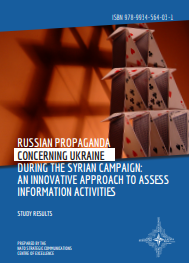
During the Syrian campaign the (dis-) information activities of the Russian Federation concerning Ukraine dropped significantly. Key narratives and topics employed by Russia vis – a –vis Ukraine a) aimed to worsen relations between Ukraine and countries of the European Union; b) repeated and added new details to a previously actively exploited narrative on the illegal, outrageous, violent and aggressive behavior of Ukrainian battalions in the Donbas region; c) drew different connections between Ukraine and the war in Syria and especially DAESH; d) repeated a previously widely spread narrative about the illegal nature of Maidan, and the fascist government in power in Ukraine. Narratives aimed at countries of the European Union strove to increase tension among European countries and between European countries and the United States of America, and to create the impression of growing sympathy towards and support for Russia in the region. Additionally, the narratives aimed at creating ideological clashes and distrust among countries within the European Union and painting a negative image of Ukraine. SOURCES This research is based on the European External Action Service Disinformation reviews for the period under observation. Key narratives and themes of disinformation activities against Ukraine and countries of the European Union have been identified. An assessment of the intensity of (dis-) information activities was made by analyzing such sources as ria.ru, rt.com.ru, aif.ru, vesti. ru and r24.ru. METHODOLOGY The research is based on qualitative and quantitative content analyses, accompanied by innovative methodology to assess (dis-) information activities. The Bohush Pyramid of Influence method allows for analysis of (dis-)information activities according to the perceived target – at what level of influence is the activity aimed, what perception is it intended to produce, and what kind of consequences are envisioned for this particular (dis-)information activity at this particular level for this particular audience. PERIOD UNDER STUDY The period of the Syrian campaign from September 2015 to March 2016 was a time of information support for the Russian Federation active phase of military operations in Syria. Hereafter, in this study it will be referred to as the Syrian period. In order to ensure the accuracy of the results, given the fact that the official Syrian campaign began only in the last two days of September, the Syrian period is measured and presented in charts from October 2015 to March 2016. For illustrative purposes and strength of comparison, the time frame of the research has been expanded to cover the period from June 2015 to May 2016.
More...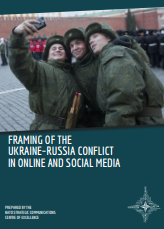
The aim of the project is to describe and reconstruct the information campaign carried out by Russia and pro-Russian activists in the internet and to reconstruct representations and frames of the Ukrainian-Russian conflict emerging from internet commentary sections and social media posts. Textual and visual analyses reveal the tools and methods used by pro-Kremlin commentators to build representations of Crimea’s annexation and the Ukrainian-Russia conflict. The subject of analysis is the framing of how the Ukraine–Russia conflict played out in internet portals (DELFI, korrespondent.net, pravda.com.ua, kyivpost.com and onet.pl) and social media (Facebook, Vkontakte) in the period from 1 April to 31 December 2014. The effectiveness of influence on the internet were also analysed, particularly in mobilizing internet users to engage in communication.
More...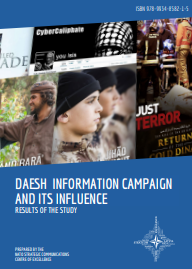
The terrorist organization, Daesh, also known as the so-called ‘Islamic State/IS/ISIS/ISIL’, has launched an extremely sophisticated information campaign targeting a wide range of audiences around the world to gain support for its expansion in the Middle East. Daesh first strategic success was the public address of self-styled Caliph Abu Bakr al-Baghdadi proclaiming the existence of a renewed Islamic Caliphate. The speech drew immediate and lasting attention. The NATO StratCom COE was asked to conduct research into Daesh information strategy in order to gain a better understanding of how the Daesh information campaign is managed, and to propose practical solutions concerning the situation in the Middle East. The methodology for analysing Daesh information strategy included examining the issue from a number of aspects related to strategic communications such as social psychology, communication, and social media analysis. The work was done in collaboration with experts and advisors from NATO member states in order to achieve the best result. StratCom COE research into Daesh information strategy shows that the spectrum of the problem is much greater than only recruitment and radicalization alone. Roots • Fifteen years of insurgency, including the experience of the former soldiers of Saddam Hussein’s regime and foreign fighters from all over the world, have given the group a deep understanding of how to effectively shape the information environment. • The proclamation of ‘the Caliphate’ and the release of a propaganda publication entitled This is the Promise of Allah by the Alhayat Media Centre provide information about the future plans of the organisation and give an indication of goals of the Daesh information strategy. • One year after Abu Bakr al-Baghdadi’s speech, many organizations have pledged allegiance or offered their support to Daesh. This support is instrumental, not only for conducting terrorist attacks, but also for amplifying the Daesh Information Strategy globally. Structure • Daesh is divided into specialised councils and departments at both the global and regional levels. A specific group within the structure is responsible for shaping the information environment by disseminating different kinds of messages, however, each department plays an important role and contributes to the effectiveness of their information strategy. Information Strategy • The name of the organization represents the core message of the group. The group wants to be described by westerners as ‘the Islamic State’, and by Middle Eastern audiences as ‘ad-Dawlah al-Islamiyah’, ‘ad-Dawlah al-Caliphate’ or ‘the Caliphate’. • Daesh narratives can be divided into three main themes: Political, Religious, and Social. • The main efforts of the information strategy can be divided into four types of messages or Lines of Effort (LOE)—to Unite, Frighten, Support, and Inform. • The most effective LOE for western audiences from the point of view of the organization is the one spreading information about success of the group. The group seems to be aware of this, since informative messaging has increased significantly since the beginning of the information campaign. • Various tools, including social media propaganda, direct physical actions, and computer network operations are used to access or target potential audiences. • Twitter is used as an umbrella media platform that connects various media sources into one easily browsable and searchable information index. • Daesh uses the Twitter community structure as a defensive structure against account deletion and suspension. The structure is able to recover quickly by organizing in a number of small communities and some larger ones. Conclusions • The effectiveness has its roots in what was done at the beginning. Proclamation of the Caliphate, speech of Abu Bakr al-Baghdadi, and strategic guidance for future plans made the group strong enough to draw attention of different countries, media and terrorist organizations. • Various audiences perceive the name of the organization differently. Since ‘perception is reality’, the choice of name used for communication purposes is crucial. • Religion underpins Middle Eastern societies. Daesh uses the radical interpretation of religion for its most effective communication. • Recruitment campaign, done internally and externally by group members has incredible meaning in overall Daesh campaign and at the same time it is the main concern of many countries around the globe. • Actions speak louder than words. Daesh knows that it is more important to take action than to merely declare intentions. In other words, Daesh is aware of the importance of avoiding ‘say-do gaps’. • Daesh is well versed in persuasion techniques that manipulate not only its adversaries, but also its own members and supporters. By paying close attention to the basic principles of influence we can identify the ways in which the group implements its strategy and the reasons its information strategies are so effective. Recommendations • It is necessary for all countries to understand Daesh’s strategic goals and how they formulate their messages. The key to success in countering Daesh at every level and building resistance to Daesh messages through the education of home audiences, is understanding how the structure works and who the potential target audiences are. • Language and terminology matter. Therefore, the words used to spread information and counter messaging should be carefully chosen. • A unified linguistic and strategic approach is needed to disrupt the networking Daesh does through various social media platforms. • It is essential to encourage Muslim authorities—recognized moderate religious and community leaders— to explain the radicalism in Daesh messages, and to rebut and refute the organization’s erroneous interpretations of Islam. • From the psychological point of view, intimidation or ridicule will not be effective counter narrative strategies. Illustrating how Daesh propaganda actually works to reach its audiences and pointing out its manipulative nature will undermine the credibility of Daesh and provide a much more productive strategy. • Testimonials from disaffected and critical foreign fighters (defectors) or supporters, can be used to reveal the true face of the terrorist group. The strategy will be much more effective if the messages come from the Middle East instead of Western countries—‘don’t come here’ is a much stronger message than ‘don’t go there’. • When communicating to the outside world, emphasis should be placed on the effectiveness of a global coalition, as well as on every loss and defeat suffered by Daesh. • It is necessary to understand the principles of influence, which draw out specific behaviours, so that countries can protect their own societies from Daesh information strategies, including recruitment and the process of radicalization. Each country, society, and audience needs to have its own specialised and comprehensive approach based on local demographics and psychographics. • Since every country has its own intelligence system, which focuses on those aspects of the situation that are closest to that country, wider information sharing about Daesh actions, techniques, and strategies will benefit everyone. Security Institutions of various countries should cooperate in order to share resources.
More...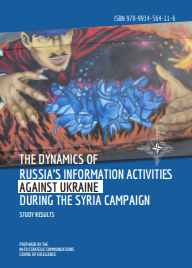
Two major geopolitical conflicts are at the core of this research. Military conflict in Syria and the related rise of terrorism carried out by Daesh, in both the region and beyond, pose an enormous policy challenge for the governments of the United States of America (US) and Europe. Simultaneously, Russia faces sanctions after it annexed Crimea – the biggest and most serious geopolitical violation of national borders in the 21st century so far. This paper provides an analysis of the dynamics and changes in the level of Russia’s information activities against Ukraine before and after the commencement of the Syrian campaign. The analysis proves that, despite the geographical distance between them, both conflicts share mutually coordinated strategic narratives promoted by Russia. This report argues that the strategic goals of the Russian government’s propaganda are the following: • to promote Russia as a crucial player in the polycentric world in the process of international peace; • to claim Russia’s superiority over the US; • to prevent Ukraine’s transformation into being part of the external border of NATO and the European Union (EU); • to soften and, in the nearest future, achieve the lifting of the sanctions regime against Russia.
More...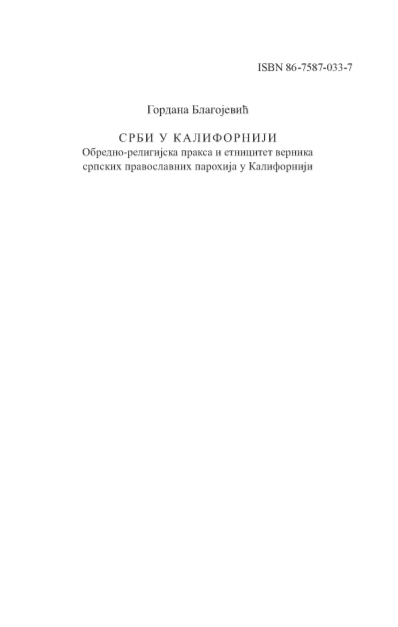
Ова књига представља прилагођен и делимично измењен текст магистарског рада Обредно-релишјска пракса и етницитет верника српских православних парохија у Калифорнији, одбрањеног у децембру 2002. године на Одељењу за етнологију и антропологију Филозофског факултета Универзитета у Београду. Рад је настао као део пројекта Етнографског института САНУ број 2157: Традиционална култура Срба — системи представа, обреда и социјалних институција, који финансира Министарство за науку и технологију Републике Србије. Желела бих да се захвалим овом министарству чији сам стипендиста била током постдипломских студија, као и Министарству културе које је финансирало моје путне тропжове до Лос Анђелеса. Захваљујем се свим колегама у Етнографском институту САНУ чијим сам се искуством користила приликом израде рада. Најсрдачније се захваљујем мојим рецензентима академику Димитрију Стефановићу, др Душану Дрљачи, др Младени Прелић на корисним саветима и сугестијама, као и ментору проф. др Бранку Ћупурдији. Посебну благодарност дугујем епископу шумадијском господину Јовану, који је током мог боравка у Калифорнији у јесен 2000. године био владика западноамерички и који ми је дао дозволу за истраживање у његовој епархији. Желим да се захвалим и свештенству западноамеричке епархије које ми је помогло да прикупим материјал за израду овог рада, посебно јерејима Блашку Параклису из Оринџ Каун-тија, Петру Јовановићу из Сан Габријела, Марку Матићу из Сан Франциска и његовој супрузи Весни, као и свим испитаницима - људима добре воље који су учествовали у истраживању и допринели стварању ове књиге. Дугујем посебну захвалност др Андреју Симићу, професору антропологије на Универзитету Јужне Калифорније у Лос Анђелесу и проф. др Димитрију Ђорђевићу, са Универзитета у Санта Барбари (Калифорнија), члану САНУ. Највећу захвалност дугујем мојој сестри Татјани и њеном супругу Зорану Миловановић, који су сносили све трошкове мог боравка и истраживања у Америци - без њихове љубави и разумевања реализација овог подухвата била би немогућа. Истинску и усрдну подршку и у овом послу пружили су ми моји родитељи, којима неизмерно благодарим на помоћи и стрпљењу.
More...
Since in our opinion ethnic identity is an important problem in the study of the complex issues of assimilation and ethnicity, we have tried to determine to what extent and why the Serbian emigrants in Chicago have preserved their ethnic identity and what have been the forms and factors of its manifestation in the multinational environment of Chicago. As little attention has been paid to this problem so far, we collected the most important data during the field research by combining participatory observation, interviewing and casual conversation, although we also used all the available literature, statistical sources (census, etc.) and the emigrants’ publications (newspapers, commemorative volumes, calendars, bulletins, etc.). The Serbian emigrations to Chicago have had all the characteristics of the emigrations of other Yugoslav nations to America. They began at the turn of the 19th and 20th centuries, and they have been taking place with changing intensity ever since. Therefore this paper covers three generations of Serbian emigrants. There have been three waves of emigration, differing in the region, time and cause of emigration and the socioeconomic characteristics of the emigrants. The first-wave emigrants had come to Chicago until World War Two for economic reasons, and they were mostly from Lika, Bosnia-Herzegovina and Montenegro; only at the end of this and in the subsequent waves was there a large number of emigrants from Serbia. Most of them under-educated or even illiterate and without knowledge of the English language, they usually found employment as factory workers or poorly paid laborers. The second wave consisted of emigrants who came after World War Two, mostly until 1960, as political emigres or displaced persons. The third wave, consisting of economic emigrants, began in 1960 and is not yet over. The socioeconomic status of the emigrants of the last two waves has been much more favorable because of a greater share of skilled workers. (The third wave has also been characterized by a much higher proportion of highly Skilled workers.) Since now they are coming to Chicago with professional experience, as soon as they learn the language, they begin to advance. On coming to Chicago, the first emigrants were faced with a new environment whose language, customs and habits were something altogether new to them. Besides, their adaptation to the new conditions of life was often accompanied by intolerance on the part of the members of groups which had emigrated earlier and by the unhospitability of American society. Therefore the old emigrants founded their colonies and institutions (parishes, relief societies, Serbian schools, choirs, e ts ...) in poor districts of the city. The emigrants of the subsequent waves, especially the third, usually settled in colonies whose breakup began at the time of their coming to Chicago, but they remained active in the old emigrant organizations or founded new ones, more suited to their needs. The emigrants’ families and organizations have formed an emigrant community, to an extent isolated from the rest of American society, in which our emigrants are still largely leading their private and public lives. Different times of emigration and differences in the socioeconomic status of the emigrants and generations have reflected on the status of their descendants in American society, and still more on the preservation of their ethnic identity, so that the members of the second generation can be divided into two types: the first type includes the descendants of the first-wave emigrants; and the second type, the post-World War Two emigrants. As a satisfactory definition of ethnic identity must include both its subjective and objective aspects and also have a symbolic character, in this paper we shall take ethnic identity to denote group identity which the members of a group form on the basis of a series of symbolic notions about their common characteristics, and/or which is formed by others who identify them as members of a group on the basis of these notions. Ethnic identity is formed and manifested through a series of ethnic symbols. Their basic function is to express the Serbian communal spirit. In addition to this marking role, they also have a differentiating role.. They separate our emigrants from the majority of the American population, which includes not only the white Anglo-Saxon Protestants but also all other ethnic groups in the city. We have grouped the ethnic symbols into two large symbolic systems: the verbal (language and personal and family names) and the nonverbal (religion, music, food and decorative objects). We have analyzed each of these symbols separately, with an intention of showing how it is used and how it changes and functions in the lives of the emigrants of different generations, waves and types. The first generation has, as expected, preserved its ethnic characteristics and is manifesting them more or less visibly both in the emigrant community and in American society at large. The second generation has lost some of the ethnic symbols, such as language, which has led some researchers to conclude that the second and, especially, the third generations have been largely assimilated. Ethnic identity, however, is based on a number of ethnic symbols, and loss of one of them does not entail loss of ethnic identify because its function can be taken over by other symbols. The later generations of Serbs in Chicago are cherishing symbols of their ethnic identity best suited to their needs and the conditions of their life (mostly nonverbal symbols). Apart from generational affiliation, the preservation of ethnic identity is affected by a series of other factors. On the one hand, there are emigrant-community factors (type of migration, type of colony, participation in ethnic organizations), which along with the contact with the homeland are contributing to the preservation of ethnic identity. On the other hand, American-society factors (naturalization, immigration policy, school system, social mobility) are contributing to the disappearance of ethnic identity. The opposite effects of the emigrant community and American society are giving rise, especially among the members of the second generation, to dual identity, which is symbolically manifested in the cherishing of both Serbian and American symbols, even simultaneously. The third generation, however, is characterized by an increased interest in the elements of the traditional culture of their ancestors. This is a generation most affected by the cultural pluralism and ethnic revival movement of the 1970s. Today the activities of various ethnic organizations in Chicago already cover the fourth and fifth generations of our emigrants, so that it is very likely that, although now being school-age children, they will preserve other ethnic characteristics besides the awareness of their ethnic origin. The emigration of Serbs to Chicago still continues, contributing to the constant revival of Serbian ethnic elements. Therefore we can assume that the Serbian ethnic group in Chicago will not completely disappear in the foreseeable future and that lit will preserve ethnic characteristics best suited to the needs of the emigrants and the conditions of the life in the multi-ethnic environment of Chicago.
More...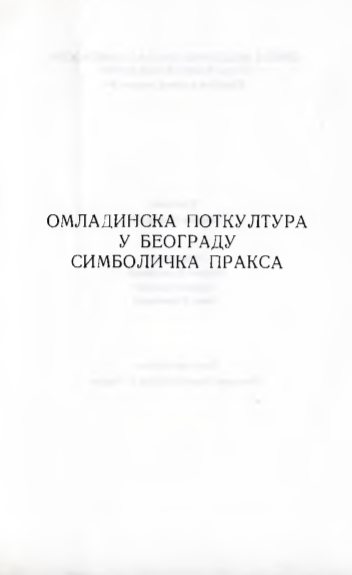
Овај рад је писан у сенци три велике сумње: а) многи су сматрали да поткултуре код нас уопште не постоје, б) други би и уочавали њихово постојање (додуше као маргиналиих друштвених и културних појава), али не и мотив да се оне научно третирају, ц) трећи су те недоумице решавали тако што су једноставно cматрали да то није посао за етнолога. Од недавно, пажња јавности кoја се cве више поклања поткултурама, као да те сумње претвара у заблуде. Поткултура је у медијима, поткултура је у публицистици, проналази cвоје место и у науци, има је чак и у званичним расправама. Оснивају се специјализовани часопиcи који вапе за текстовима (помало затечених) аутора. Захтева се темељит приступ: поткултура са cоциолошкoг, психолошкoг, филозофског, уметничко-теoриjcког становишта... придружују се демагошки, сензационалистички, произвотно-журналиcтички приступи. Ускоро се cваки човек од лера, „коме је иоле било стало до cебе", труди да папише нешто и о „поткултури”. Млади, супкултура, алтернатива... постају цењене, а убрзо и „друштвено кориcне” таме. Открива се да је и новокомпонована музика „поткултурна (!), и ова „промоција" претвара „испреcање жучи" на ту музичку врсту у нови, благи, аналитички приступ. Цветају гeнералне поделе наше културе на ове или оне моделе, од којих је бар један обавезно — подкултурни.
More...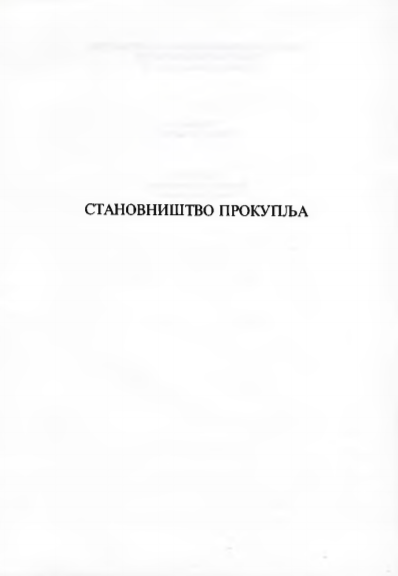
Geographical position of Prokuplje varied, depending on the importance of the region in a particular historic period. At the time of the Roman Empire Prokuplje was situated on the road connecting Lješ and Niš. A fortress (castellum) manned with soldiers securing peace and order, and protecting transportation of commodities and armies in the area was arected on the nearby hill Hisar. During the Turkish reign Prokuplje was again located on the important communication way between Dubrovnik and Istanbul, and this is the reason why between Dubrovnik and Istanbul, and this is the reason why some of the most significant Dubrovnik colonies were concentrated in Prokuplje and in Novi Pazar. Once the railways Doljevac-Prokuplje in 1925 and Prokuplje-Kuršumlija-Priština in 1948 were constructed its position continued to gain in importance. It should be added that a motor road connecting Niš and Pristina passes through Prokuplje and that Prokuplje and the adjacent towns are all connected ba a network of modem roads. Its favorable geographical position has had a definite impact on its demographic development. Archeological investigations in the region confirm that it was populated already in the prehistoric times. Its first inhabitants were members of the Illyrian tribe Dardanians followed by the Celtic tribe Scordisci. At the time of the Roman conquest severe battles were fought with the Celtic inhabitants and those who remained were resettled in Pannonia. Slavic settling in the area was completed by the seventh century. Serbs remained to live there in peace and in war with Byzantium all the way up to the Ottoman conquest in 1454. The region played an active and important part at the time of Stefan Nemanja as well, which may be deduced from the fact that his palace was located in Kuršumlija. The oppressed Serbian population, taking advantage of each and every opportunity, frequently rose up against Turkish slavery. Massive Serbian uprisings against the Turkish rulers took place at the time of Austrian-Turkish wars in 1690 and 1737. After these wars, fearing Turkish revenge, the Serbs, emigrated to the lands north of the Sava and the Danube, leaving behind their centuries-lond homeland. A powerful and successful uprising took place in 1876-1878 when the Toplica region was finally liberated and joined to the state of Serbia. After the liberation from the Turkish reign Prokuplje, finally free, became a strong immigrant point of attraction once again. Prokuplje and its environs were this time populated by immigrants from Montenegro, Herzegovina, Kossovo, Metohia, Kopaonik, environs of Užice, the Vojvodina, Crna Trava and other regions. The result of these migrations was the extremely heterogeneous population structure of Prokuplje, namely its members originated from many different regions. Demographic and socioeconomic development of Prokuplje was disrupted by the 1912-1918, and 1941-1945 wars. These wars had extremely negative effects on population and household growths in Prokuplje. After the Second World War an accelerated development of urban settlements continued in general and this was also true for Prokuplje. These processes invoked the rural-urban migrations because peasants could rather easily find employment in towns. This process was so pronounced in Prokuplje that 60% of its population are the rural immigrants. Prokuplje became the center of daily commuters: workers and pupils. The existence of so many commuters is conditioned by various factors: traffic development in Toplica, underdeveloped economy so that workers have to engage themselves in agricultural production as well, housing shortages in the town and so on. After the Second World War immigration of Serbian inhabitants from Kossovo and Metohia became more intensive. These migrations were provoked by the actions of Albanian separatists and nationalists, further by the bad policy of the Yugoslav League of Communists leadership, and by the failures of the state agencies and institutions. Population and household increase in Prokuplje after the liberation from the Turkish reign was the result of the influx of Serbian population from various directions, while after 1960 rural-urban migrations were the chief factor in population growth. Population increase due to birth rates is extremely modest, the average rate being 9% for the period of the last ten years. Population structure (gender, age, education, nationality, confession, economy) of Prokuplje is influenced by the complex socioeconomic factors effective in the past. Gender structure was disturbed by the intensive immigration of male migrants up to the Second World War and their emigration later on, by the economic structure of the town, by wars and other factors. Age structure is on the other hand effected by decrease of birth rates which is seen from the following aging index: in 1948 0.19.1953 0.18.1961 0.21. 1971 0.22, and in 1981 0.28. Literacy is on the low level (in 1948 15.22%, 1961 12.48%. 1971 11.07%, and in 1981 7.02%) for an urban settlement with more than 25000 inhabitants. Percentage of inhabitants with collage and university degrees is increasing (1948 1.41%. 1953 2.71%. 1971 4.91% and in 1981 7.35%). This increase is in accord with the economic, cultural, medical-care and communication development of Prokuplje, the center of Toplica. National structure in the periods after the liberation from the Turks was quite homogeneous. From 1948 (89.5%) until 1981 (86.47%) the percentage of Serbs decreased. The second largest group are the Gypsies amounting to 5.34% in 1981. More than 99% of the total population in Prokuplje are of the Serbian Orthodox creed. The economic structure of the population in Prokuplje changed in correlation with the development of economic life in the town and its environs. The general activity rate in the after-war period is quite stable: in 1953 31.1%, 196132.29%, 197134.95%, and in 1981 36.44%. Increase of the general rate of activity is the consequence of the aging of the population, decrease of natality rate and the number of pupils and students as supported persons. The number and percentage of self-supporting people is increasing because of the increasing number of retired persons who return to their home town after retirement. The absolute and relative number of people employed in primary sector is in decrease, while those in the secondary and tertiary ones is in increase. The rate and type of change that has occurred in the population economic structure in Prokuplje may be seen from the following data: the number of employees in economic activities increased in the period 1953-1961 for 84.74%, from 1961 to 1971 for 72%. and from 1971 to 1981 for 30.5%, and in other activities: from 1953 to 1961 for 19.5%, from 1961 to 1971 for 25.95%, and from 1971 to 1981 for 56.08%. In the following period both the population growth and the changes in population structure will be moderate for it is not expected that the town would experience abrupt changes in its development.
More...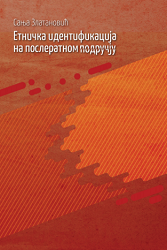
This study is based on long-term in-depth research in the south-east of Kosovo (part of a broader area known as the Kosovsko Pomoravlje or Morava river basin), in the areas of the Gornja (Upper) and Donja (Lower) Morava (in the town of Gnjilane – the regional centre, and in the surrounding villages of Šilovo, Gornji Livoč, Gornje Kusce, Parteš and Pasjane; in the township of Vitina and the surrounding villages of Vrbovac, Grnčar, Binač, Mogila and Klokot; and also in the villages of Letnica and Draganac because of their religious significance). I also conducted research among displaced people from this region in few towns in Serbia: Smederevo, Vranje and Vranjska Banja. The research was carried out between 2003 and 2006, but I remained in contact with some of the interlocutors and continued to keep track of community dynamics within the region for a number of years subsequently. The fieldwork was conceived as multi-sited (Marcus 1995), because it was about a migratory situation. The terrain was defined as a network of localities (Hannerz 2003a; Hannerz 2003b). The aim of the research was to study the relationship between ethnicity and other forms of identification (religious, regional, local, gender) of the Serbian community of south-east Kosovo in a profoundly changed post-war situation following the establishment of the international administration in Kosovo, in 1999. My intention was to make an empirical and analytical contribution to our understanding of the complexity of social interaction from different perspectives “from below”, in a specific frontier and post-conflict region such as Kosovo. In the last decades of the 20th century, the identities of Kosovo became homogenized and acquired fixed boundaries, ethnic identification becoming more relevant than other forms of belong ing. Ethnic identity, as shown in numerous studies, gains in importance in unclear situations, in periods of change and crisis, when conditions are in place for the experience of threatened boundaries (Eriksen 2002: 68, 99). Kosovo is a prime example of how political and other interest groups construct and mobilise, direct and exploit ethnic identities. Since 1999, Kosovo has been inhabited almost exclusively by Albanians. The Serbs are a minority, ghettoized into small enclaves and rural environments. Many other ethnic, religious and/or linguistic groups have been displaced or assimilated. War provokes great social disruption and change; a constituent element of this is migration. The experience of war and forced migration of one part of the community changes the ways of both self-identification and the identification of the other, thus re-defining intra-ethnic and inter-ethnic relations and boundaries. As much research indicates, armed conflict is preceded by processes of homogenization within communities, the strengthening of boundaries and the assimilation of various types of identification into the ethnic. In a post-war context, with radical changes in the ethnic and social landscape, processes of articulation and re-articulation of identity have opened up in the Serbian community, rendering problematic its differing aspects. This research aims to extend our understanding of such processes. The study is divided into seven chapters. The first two establish the theoretical, methodological and analytical framework of the research. The third chapter, “Kosovo – a frontier region” aims to place the researched community in context. Processes of identification in frontier areas are specific in several respects. The results of many studies show that in the frontier and peripheral areas, group boundaries are less well-defined and more fluid, and identities – not only ethnic, but religious and others – are undetermined, situational, ambivalent and multiple (in contrast to those in central areas) (Duijzings 2000: 13, 24; Wilson, Donnan 1998: 13). In these areas, changing identity and/or recourse to various forms of mimicry may be the only way to survive in certain political and social circumstances. Kosovo is a paradigm of these processes and solutions. This chapter also deals with the history of Kosovo, paying particular attention to the period of the Socialist Federal Republic of Yugoslavia, the escalation of the conflict and the introduction of an international administration. Special attention is paid to the connection of the Serbian Orthodox Church with Kosovo. Next, the basic characteristics of the community are outlined: dense social network, the meaning and importance of internal boundaries, linguistic practice, etc. The fourth chapter, “Living in a post-war region” examines everyday life, family and gender relations, identity discourse on traditional female costume and wedding. This chapter deepens the analysis of the connection between ethnic and religious identification of the researched community (hybrid cultural practice, particularly in the sphere of religion, the role of the Serbian Orthodox Church in the post-conflict period, pronounced traditionalism, etc.). The Serbian Orthodox Church has great influence as the only Serbian institution that remained in Kosovo after the withdrawal of the Yugoslav and Serbian military and police in June 1999. For the Serbian community in Kosovo, the Church has much greater significance than simply as a religious institution; it is seen as the only institution that did not abandon the community in hard times. The members of the Serbian community of south-east Kosovo primarily thematize ethnicity with religious rituals and markings. Religious and ethnic identification become blended in such a way that the religious is in function of the ethnic. Finally, this chapter gives a detailed analysis of the paroxysm in the ethnisization of reality. The next chapter is devoted to intra-ethnic relations and boundaries. Even though “externally” and/or from the “top down”, the Serbian community of Kosovo is defined as homogenous, its members within their own community, identify sub-group distinctions which cause tension. In the post-war context of evident ethnic homogenization, solidification and boundary closure, intra-ethnic categorization and the accompanying tensions it remain current and, in relation between Kosovo Serbs and Serbs from Serbia, gain new dimensions. For this reason, it is necessary to take a flexible approach to ethnicity which neither assumes a priori intra-ethnic homogeneity nor inter-ethnic heterogeneity (Talai 1986: 252, 266). Inter-group perceptions between the old inhabitants and the colonists are also addressed in this chapter as well as their implications. Then the analysis of the external definition – categorization of the so-called ‘Serbian Gypsies’ ensures (the term ‘Serbian Gypsies’ [Srpski Cigani] is used tentatively, since it is an exonym) and the long road this group have traveled from inter-ethnic towards intraethnic other (Zlatanović 2017). In the light of the post-war migrations, attention is paid to discourse and practice in relations between the displaced people of Kosovo and the population in Serbia. The sixth chapter explores inter-ethnic relations and boundaries. First, attention is given to the discursive construction of the Kosovo Croats are defined in discourse, and the over-coming of religious boundaries. Next, the focus is on the most important, most complex and most ambivalent other – the Albanians (analysis of the basic characteristics of the discourse on the Albanians, the problem of naming, overcoming of boundaries – through cooperation, friendship, religion, and insight into the consistency of boundaries – mixed marriages were almost unheard of). The relations between members of the Serbian and Albanian communities are also considered beyond ethnicity, since there are many shared elements of identification that connect them. The final chapter offers some concluding remarks on the relation between ethnicity and other forms of collective identification of researched community.
More...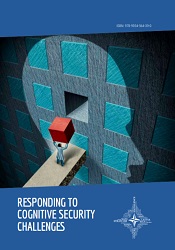
This research product is a collection of different efforts, united by a common goal: to identify some of the most critical security challenges in online environment and what can be done to counter them, and to determine the role of governments and state institutions in countering them. People spend increasing amounts of time online, either communicating, networking, entertaining themselves, or obtaining news. On the one hand, this narrows the number of places analysts must look at when assessing the information environment, on the other, we have yet to fully tap into the analysis potential for this enormous space and leverage it to increase the effectiveness of our communications.
More...